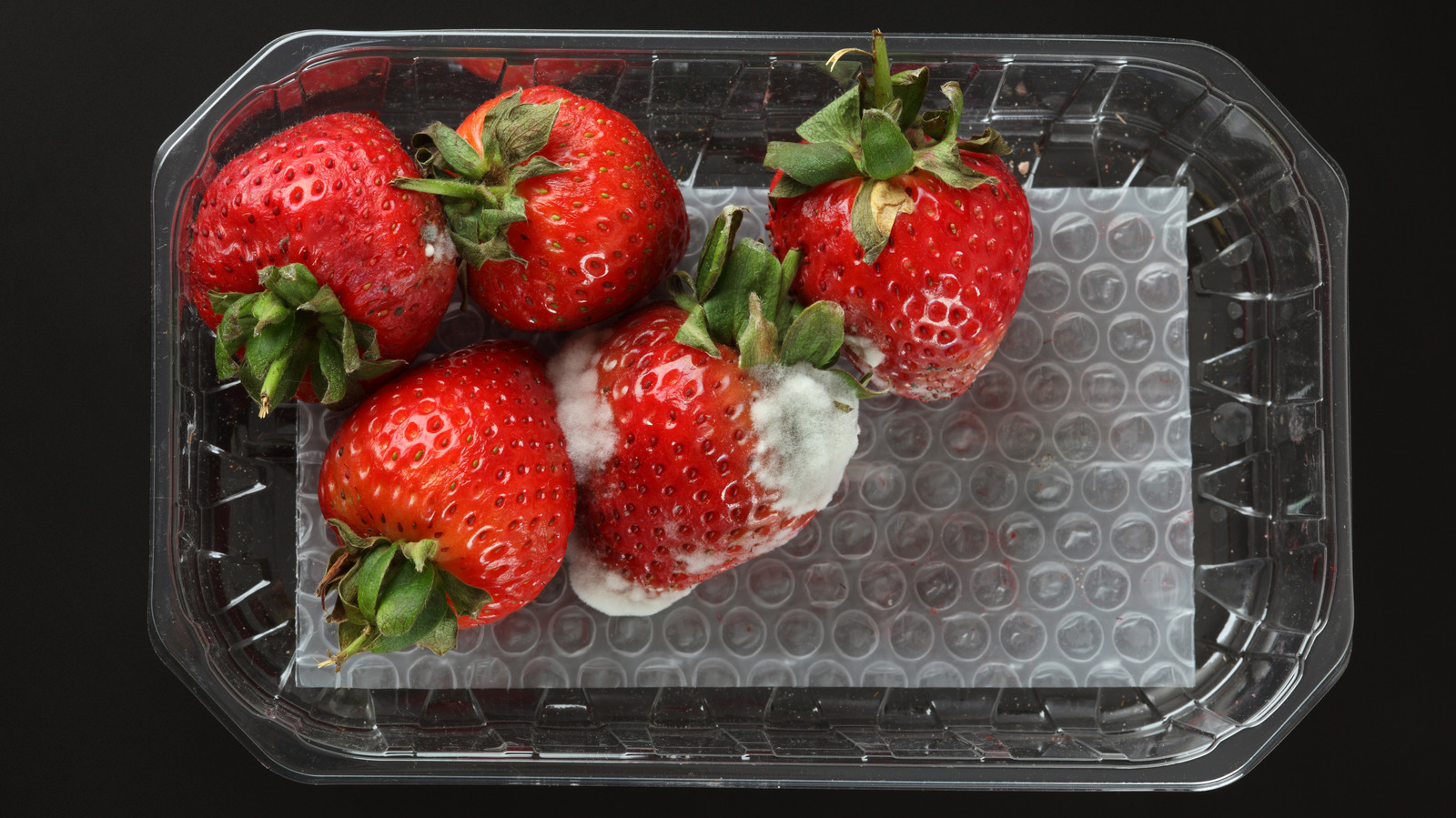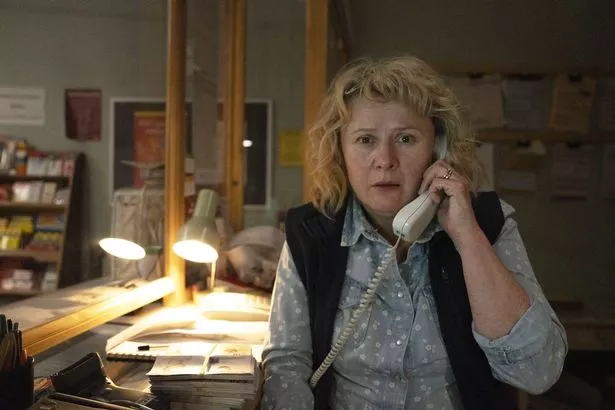
If You Accidentally Eat Mold, This Will Happen – The Daily Meal
Typically, nothing too bad will happen if you notice a little bit of mold on the strawberry you’ve been eating. You might feel grossed out by the ordeal, but you are not in real danger. All you have to do is simply spit out whatever moldy food is in your mouth and throw the rest away.
Because most serious mold-related sicknesses are caused by breathing mold in over a long period of time, not ingesting a little bit on accident, the amount you might eat without noticing is likely too small to hurt you. But if you start feeling sick after you accidentally eat mold, call your doctor, as it might be a symptom of something more serious. However, if you ate a moldy piece of toast thing morning and didn’t notice it until halfway through, don’t panic. These are a few things to look out for over the next few days to make sure you are okay.
If you cut mold off food, is it now safe to eat?
 Dobrila Vignjevic/Getty Images
Dobrila Vignjevic/Getty Images
If you are about to take a bite of your sandwich and notice a spot of mold on the bread, it makes sense just to cut off that portion and continue eating, right? Well, unfortunately, cutting off visible mold from food is not a foolproof method for making it safe to eat. While it may seem like a reasonable approach to salvage the remaining portion of the food, it is important to understand that mold can have invisible roots that penetrate deeper into the food, extending beyond what is visible on the surface. Mold does this to feed itself, so it can continue to grow. These roots can contain mycotoxins that can harm you if you eat them, even if the mold itself is removed.
If you only cut off the mold you can see with your naked eye, you might not actually be getting all of it. This means you might still get sick from ingesting the food. In addition, mold also usually produces spores, even if it is only a tiny amount. These spores can land on other areas of the food, contaminating it. You won’t be able to tell just by looking at it. So it’s best to just throw away the entire thing if you notice any mold on your food.
How does mold get on your food?
 Solidcolours/Getty Images
Solidcolours/Getty Images
There are lots of different ways mold can show up in our food, even if we try our best to prevent it. This is because mold spores are always present in the air around us, both indoors and outdoors. They are tiny, lightweight particles that can travel through the air and settle on surfaces, including food. When the conditions are favorable, like there is lots of humidity or warm temperatures in an area, these can really start to grow as mold thrives in these warm, damp environments.
However, sometimes mold doesn’t come from the air. In fact, the food you buy at the grocery store might already be moldy when you bring it home. You just can’t tell yet. For example, fruits and vegetables may have mold spores on their surfaces even before they are harvested. If these ingredients are not properly washed or stored, the mold will start spreading and ruin the entire batch. You can try to prevent this from happening by keeping perishable items refrigerated. Also, regularly clean your refrigerator to get rid of any older items that might spoil and take other, fresher foods down with them.
You might have an allergic reaction if you eat mold
 Paul Bradbury/Getty Images
Paul Bradbury/Getty Images
While eating mold is a little bit gross to all of us and might cause a reactionary upset stomach after we find out, some people might have a genuine allergic reaction to it. Just like any other allergy, the specific symptoms and severity of the allergic reaction can vary from person to person. It will all depend on the individual’s sensitivity, the type and amount of mold ingested, and the overall health of the person. However, the symptoms will typically be uncontrollable itchiness, breaking out into hives, compulsive sneezing, or difficulty breathing.
While all of us should strive to avoid accidentally eating mold, if you have ever shown any of these symptoms in the past, you should be extra cautious and avoid consuming any food that shows signs of mold growth. Allergies have a tendency to get worse after more exposure to the toxins that trigger them, so you don’t want to put yourself in danger.
You can expect to experience food poisoning
 Kmpzzz/Shutterstock
Kmpzzz/Shutterstock
Food poisoning is a very uncomfortable experience; unfortunately, moldy food can trigger it. This is because of the harmful myotoxins contained in most mold that grows on food. When you realize you’ve eaten something moldy, you might immediately feel sick because of the “ick” factor of the situation. However, food poisoning is a bit more serious and doesn’t typically set it until a few hours after the fact. Common symptoms of food poisoning include nausea, vomiting, abdominal pain, diarrhea, dizziness, and in some cases, fever.
There is really no telling how long mold-induced food poisoning will last. In most cases, you will feel better within a few days. However, in severe cases or with prolonged exposure to high levels of mycotoxins, symptoms can persist or worsen, requiring medical attention. You can try to ride out your mold-induced food poising with plenty of rest, liquid, and over-the-counter medicine to settle your stomach. However, if symptoms do not improve after 48 hours, it’s best to stop into an urgent care to be seen by a doctor, just in case. You want to ensure you are not having an allergic reaction to the mold, nor become so dehydrated that your body can’t fight off the bacteria any longer.
You might develop something that feels like a sinus headache
 South_agency/Getty Images
South_agency/Getty Images
Although a rare symptom from just accidentally eating a little bit of it, mold can cause headaches. This is because when you breathe in the spores on the food, they irritate your nasal tract. This can lead to a pressure buildup in your sinuses, triggering a headache. Typically, this pain is the result of breathing in the mold for a prolonged period of time, as if it was growing in your air conditioning vent and you were unaware. However, large quantities of mold on foods could also produce similar circumstances.
In addition, if you are allergic to the specific type of mold that you consumed in your food, your headache could be your body’s reaction to the myotoxins entering your system. In this case, the headaches are typically more severe and might feel more like a migraine. If you accidentally ate some mold and notice a headache develop, keep a close eye on it. If it doesn’t go away with plenty of liquid and over-the-counter headache medicine, it could be a sign it’s a symptom of mold exposure, and you could need medical attention.
You might feel very fatigued
 Andresr/Getty Images
Andresr/Getty Images
Not all instances of fatigue are directly related to mold ingestion, as there are lots of medical causes for the condition. However, if you suddenly find yourself exhausted after eating something with mold on it, the two might be linked, although you typically won’t accidentally eat enough mold to cause a real problem. Yet because certain molds produce mycotoxins, these toxins can make us really sick, which will manifest as excessive tiredness.
This will come across as an overall lack of energy and difficulty staying awake or maintaining normal activity levels. Other accompanying symptoms may include brain fog, difficulty concentrating, muscle weakness, and a general sense of lethargy. Individual sensitivity to mold and its toxins can vary. Some people may be more prone to experiencing fatigue or other symptoms after consuming moldy food, while others may be less affected. It’s also worth noting that breathing in mold spores for an extended period of time can cause similar symptoms. Your chronic fatigue might not be coming from your moldy sandwich but rather an overgrowth of spores inside your walls.
Mold can trigger respiratory issues
 Bymuratdeniz/Getty Images
Bymuratdeniz/Getty Images
Consuming moldy food can potentially lead to respiratory problems in some people. This is more likely to happen if the mold produces the spores or mycotoxins that are known to irritate the respiratory system. Mold spores can be released into the air from moldy food. If these spores are inhaled while you are eating, they might cause your respiratory system to become irritated. The presence of mold spores in the respiratory system can lead to inflammation, wheezing, shortness of breath, chest tightness, nasal congestion, sneezing, and throat irritation.
This is because when you breathe in the mold from old food and it touches your mucous membranes, the immune system may produce specific antibodies called immunoglobulin E (IgE). IgE triggers the release of histamine and other inflammatory substances, leading to allergic symptoms. If you have asthma, the respiratory symptoms you experience from eating mold-contaminated food might be worse.
You might find the skin around your mouth is irritated
 Kmpzzz/Shutterstock
Kmpzzz/Shutterstock
Eating moldy food might cause you to break out in a rash. If the mycotoxins in some molds come into direct contact with the skin, they can cause inflammation, redness, and itchiness. This is especially likely if you have a pre-existing sensitivity or allergy to mold. Of course, the chance of a skin reaction from accidentally eating mold is low. This is because the amount of mold you might eat without noticing is small, thus the exposure to your skin is low. However, if you have particularly sensitive skin, it is still possible. These symptoms will usually pop up around your mouth, near your nose, and on your hands if you didn’t use a knife and fork.
If you experience skin irritation after contact with moldy food, don’t worry. Just rinse the affected areas gently with cool water to remove any potential traces of mold or mycotoxins. Avoid harsh soaps or irritants that could further aggravate the skin. If things aren’t getting any better, you might also try over-the-counter topical treatments, like hydrocortisone cream or calamine lotion, which may help alleviate itching, redness, or inflammation.
You might get a fungal infection
 Stevecoleimages/Getty Images
Stevecoleimages/Getty Images
Eating moldy food can potentially lead to fungal infections in the mouth, throat, or elsewhere in your digestive system. While not all fungal infections are caused by consuming moldy food, certain molds can produce spores or mycotoxins that, when ingested, can contribute to the growth of fungi in the body. Although it is not a common occurrence from eating moldy food in small amounts, common symptoms of bodily fungal infections may include redness, itching, inflammation, and blisters.
In some cases, fungal infections can also affect internal organs or cause systemic symptoms such as fever, fatigue, or respiratory problems. If this happens to you, you will need to seek medical attention right away. The treatment for bodily fungal infections typically involves antifungal medications, like topical creams and ointments, if it’s outside your body. If the infection is inside or particularly bad, you will take oral medication, too. These medications work to eliminate fungal overgrowth from the bad food and get you feeling like yourself again.
You might suffer adverse neurological effects
 Pixelseffect/Getty Images
Pixelseffect/Getty Images
While it is possible for eating moldy food to lead to neurological symptoms in some people potentially, it is relatively rare. Some molds produce mycotoxins that have the potential to affect the nervous system in a negative way. If these mycotoxins are consumed in significant quantities, they may reach the bloodstream and cross the blood-brain barrier, potentially leading to neurological symptoms.
The type of symptoms you experience from eating mold is widely varied. It all depends on your individual sensitivity level, the type of mold or mycotoxin you ate, and how much of it you consumed. If it was just a little bit, you are likely to be fine. But if you ate a significant amount, symptoms might set in. These would be things like tremors, difficulty with concentration or memory, mood changes, anxiety, confusion, or coordination problems. In really rare cases, more severe symptoms such as seizures or hallucinations may occur. This can be distressing to experience, so seek out medical help as soon as you notice the onset of symptoms.
You might develop liver toxicity
 Shidlovski/Getty Images
Shidlovski/Getty Images
Significant liver damage from consuming moldy food is relatively low for most people. However, if you have pre-existing liver conditions and your symptoms flare up after eating moldy food, you should contact your doctor right away.
While consuming moldy food is unlikely to directly damage the liver, it is possible that certain molds can produce mycotoxins that, if ingested in significant amounts, may potentially affect liver health. This is because the liver plays a vital role in detoxifying the body. You might see mycotoxin-induced liver damage manifest as hepatotoxicity (liver toxicity) or liver inflammation. Symptoms include jaundice (yellowing of the skin and eyes), dark urine, pale stools, and unexplained weight loss. However, it’s important to note that these symptoms are more commonly associated with other liver conditions, such as viral hepatitis or liver disease, and are not specifically limited to mycotoxin exposure. Either way, if you experience these symptoms, go to the hospital right away.
Eating mold can trigger systemic inflammation
 New Africa/Shutterstock
New Africa/Shutterstock
Although an uncommon problem from eating a little mold, mold exposure, even on accident, can trigger systemic inflammation in the body. This is because when we inhale or ingest the mycotoxins from mold, the immune system immediately recognizes that it is under attack. So our immune cells, like macrophages and neutrophils, respond by releasing inflammatory mediators, such as cytokines and chemokines. These substances signal other immune cells to migrate to the site of exposure, leading to inflammation.
If we continue eating mold, even on accident, this prolonged and repeated exposure can lead to chronic inflammation. Systemic inflammation resulting from mold exposure can manifest as nearly every single symptom listed thus far, including fatigue, joint pain, headaches, brain fog, digestive disturbances, skin issues, and respiratory symptoms. Of course, only eating a little bit of moldy food on accident isn’t going to hurt us like this. However, if we make a habit of it for some reason, we will become very sick. Mold exposure can generate oxidative stress in the body as its mycotoxins can induce the production of reactive oxygen species (ROS), which can damage cells and tissues. The presence of ROS triggers an inflammatory response as the body tries to repair the damage, leading to systemic inflammation.


































